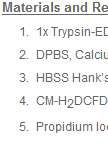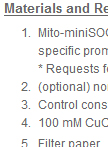往期刊物2013
卷册: 3, 期号: 1
生物化学
One-step Affinity Purification of the Chloroplast ClpP Complex from the Green Alga Chlamydomonas reinhardtii Using the Strep-tagII Epitope Tag
莱茵衣藻中的叶绿体ClpP复合体的纯化- Strep-tagII融合亲和纯化
This protocol describes the affinity purification of the chloroplast ClpP complex from Chlamydomonas reinhardtii. To this purpose, we have created a Chlamydomonas reinhardtii strain in which the chloroplast encoded ClpP1 subunit of the ClpP complex is tagged at its C-terminal end by a strep-tagII peptide.
细胞生物学
Detection of Intracellular Reactive Oxygen Species (CM-H2DCFDA)
细胞内活性氧的检测(CM-H2DCFDA)
Reactive oxygen species (ROS) play a critical role in cellular physiopathology. ROS are implicated in cell proliferation, signaling pathways, oxidative defense mechanisms responsible for killing of bacteria, thyroid hormonosynthesis, etc. The cellular Redox homeostasis is balanced by oxidants and antioxidants systems. In several diseases (cancer, neurodegenerative diseases, cardiovascular diseases), the Redox balance is disturbed. In fact, excessive amounts of ROS can damage proteins, lipids and DNA at cellular level. The choose of a sensitive method for detection of intracellular ROS is very important for detecting the disturbed Redox balance in pathological cells and after exposition of cells to different genotoxic agents (Irradiation, Oxidative stress, etc).The detection of ROS in biological systems is difficult for several reasons: Method sensibility and probe specificity. The 2′, 7′-dichlorodihydrofluorescein diacetate (H2DCF-DA) fluorescent probe is commonly employed and may react with several ROS including hydrogen peroxide, hydroxyl radicals and peroxynitrite. The cell-permeant H2DCFDA passively diffuses into cells and is retained in the intracellular level after cleavage by intracellular esterases. Upon oxidation by ROS, the nonfluorescent H2DCFDA is converted to the highly fluorescent 2',7'-dichlorofluorescein (DCF). The chloromethyl derivative of H2DCFDA (CM-H2DCFDA) provides much better retention in live cells than H2DCFDA. Dead or dying cells produces ROS. When we want to detect ROS in living cells, we have to stain cells by propidium iodide (PI) and evaluate ROS production only in living cells which are PI negative. In fact, PI intercalates into double-stranded nucleic acids. It is excluded by viable cells but can penetrate cell membranes of dying or dead cells. PI is excited at 488 nm and emits at a maximum wavelength of 617 nm. Because of these spectral characteristics, PI can be used in combination with other fluorescent probe such as CM-H2DCFDA (excitation/emission: 492–495/517–527 nm).A probe fluorescence emission can be assessed by Flow cytometry, a standard fluorometer or fluorescence microscopy using appropriate filter.Flow cytometry is commonly employed to detect intracellular ROS production. Flow cytometry measures fluorescence per cell. The cells is excited by the light source and emitted light from cells are converted to electrical pulses by optical detectors. Emitted Light is send to different detectors by using optical filters: 525 nm Band Pass Filter for FL-1 and 620 nm Band Pass Filter for FL-3. A 525 nm band pass filter (FL-1) placed in the light path prior to the detector will only allow “green” light into the detector. So, FL-1 is used in our protocol to collect green light corresponding to the oxidation of dichlorodihydrofluorescein (DCF) by ROS. FL-1 is the Green (FL-1) channel on flow cytometers. 620 nm Band Pass Filter (FL-3) only allow “red” light into the detector. Red fluorescence emission is measured in the Red (FL-3) channel on most flow cytometers.
MiniSOG-mediated Photoablation in Caenorhabdtis elegans
在秀丽隐杆线虫中进行MiniSOG介导的光切除试验
This protocol describes a method for light-inducible cell ablation in live worms. miniSOG (mini Singlet Oxygen Generator) generates singlet oxygen upon blue light illumination (Shu et al., 2011). Mitochondrially membrane targeted miniSOG (the first 55 a. a. of C. e. tomm-20 fused at the N’-terminus of miniSOG, termed as mito-miniSOG in the following) is transgenically expressed in specific cells/tissues (Qi et al., 2012). Groups of transgenic animals are illuminated under open field fluorescence light on a compound microscope or LED light setup for photo-ablation.
免疫学
Isolation, Purification, and Culture of Primary Murine Microglia Cells
原代小鼠小胶质细胞的分离、纯化和培养
The following is a detailed protocol for the isolation, purification and culture of murine brain microglia cells using neutral enzyme digestion and shaking. The protocol below is designed to isolate and culture a large number of purified inactivated microglia cells. Neutral enzyme digestion allows for minimal cellular damage and a higher cell recovery compared to other mechanical dissociative methods such as mincing. Cells cultured using this method will display the size and morphological features of microglia cells.





